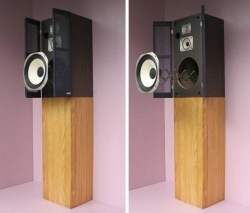Site Links

Howdy, Stranger!
It looks like you're new here. If you want to get involved, click one of these buttons!
Who's Online (8)
- blue934 12:21AM
- DrewsBrews 12:21AM
- Gowa 12:21AM
- Inertiaman 12:21AM
- jholtz 12:21AM
- rjj45 12:21AM
- Steve_Lee 12:21AM
- Tom_S 12:21AM
Please review the site Rules, Terms of Service, and Privacy Policy at your convenience. Rules, TOS, Privacy
Get familiar with the reaction system: Introducing the Reaction System
dcibel
About
- Username
- dcibel
- Joined
- Visits
- 10,370
- Last Active
- Roles
- Member, Veteran
- Points
- 2,101
- Invited by
- Bryan@MAC
- 33
- Badges
Comments
-
Send me your .MDAT file if you can't sort it out.
-
Mic in same location, properly done 2ch measurement will sum with 0 delay for this process. Measurements should not be post-processed in any way to affect phase result. Measure, window, export, that's it. REW will include all excess phase regardles…
-
I don't know that I specifically called out that anomaly as clipping, but it certainly is an odd thing to see in a measurement of loopback noise. Regardless. I know you've had all sorts of issues with your Scarlett interface of what I would describe…
-
A poor SMPS will exhibit hiss rather than hum, very different operation so the 60Hz line noise doesn't really come through. A good SMPS will be completely silent. The amp itself matters as well, some have much better PSRR (power supply rejection rat…
-
It's just power supply noise, not that interesting really. The low level transformer hum that comes through on most low-mid range amps with linear power supply. Since it's a constant unwanted noise, it comes through very clearly in FSAF. Keep in mi…
-
It's a more interesting thread than this one.
-
Inductance of resistors is inconsequential for crossovers, and typically sand cast wire wound 10W resistor is in the order of 1uH, or 0.001mH.
-
FSAF is free for everyone to use since June, just download latest REW beta.
-
Solen doesn't do sales that often. Black Friday is likely the next one.
-
Off-axis response set from above, traced, smoothed, and overlaid. Sorry, it looks fairly typical to me for this type of speaker. (Image)
-
Max SPL increase may be 6dB, I should have worded better, 3dB for the same power applied is what I meant. A4E's crossed out statement isn't wrong, it will take 3dB more power to produce that last 3dB.
-
Regardless of how you wire them, the maximum SPL the speaker can produce is increased by 3dB, and the pair of speakers will require the same power to produce a given SPL. Change in impedance from different wiring arrangements affects voltage sensiti…
-
(Quote) You'll find out for yourself soon enough.
-
If constant directivity is the goal, you'll want a larger waveguide. WG148 provides a good directivity match with 152mm midrange and 2 to 2.5kHz crossover, but will fall a bit short for an 8" woofer, though it will still be an improvement over …
-
Include the series coil and it's just a 3rd order filter. This will provide a similar result without an impedance problem. (Image) Filter transfer function comparison: Impedance comparison: (Image) I'll go back to my corner now.
-
I don't get it. What's special about it? I would want to avoid a short circuit at high frequency. It's fairly badly drawn, this is the same circuit. (Image)
-
Maybe I’ll just stop posting here, y’all can be ignorant without me.
-
Not saying, showing with measurements. Properly done dual channel measurement will compensate for the cap with no extra steps required. Response with or without cap is the same, so is timing and phase. A filter that rolls off the response will chan…
-
(Quote) Wrong! The only thing that changes when adding a cap in a two channel measurement, is decreased SNR on the low end because the signal is rolled off, literally. Here is impulse and resulting frequency response and phase for some tweeter. Gre…
-
Change series R to zero and try again.
-
"I built a speaker with USB mic and it doesn't suck" is missing the point of the 2ch method (I did too). It's about enabling the most accurate information with as few steps and potential for error as possible. Who doesn't want that? Wheth…
-
Best thing I ever did was ditch USB mics and move to a 2ch audio interface with a normal XLR mic. Details of why I've tried to capture in the single vs dual ch article linked below. For getting started, a special jig is not required, just a patch ca…
-
The hard drive platters spin in my NAS ;)
-
Looks cool, but expensive, so I'll stick with my cheap DIY solution :). Looks like a pretty great product for people that do professional audio installations. The Tun software is free to try to see what it can do. My main concern would be long term…
-
Link is fine for me, logged in or not. It's a public forum.
-
(Quote) That's a nice brew, special occasion stuff :). You found it in Texas?
-
I just love how much people stress over ultrasonic audio.
-
Higher sensitivity than Scan 10F and cheaper, but looks like a butt. I guess you can't have it all.
-
Sound power is presented, no rear wave mid tunnel is going to fix that forward facing response, more likely that it is the cause for the response in 500-1kHz range. (Image) Problem area is higher up in frequency than what that mid tunnel provides…
-
(Quote) Answer is C.
































